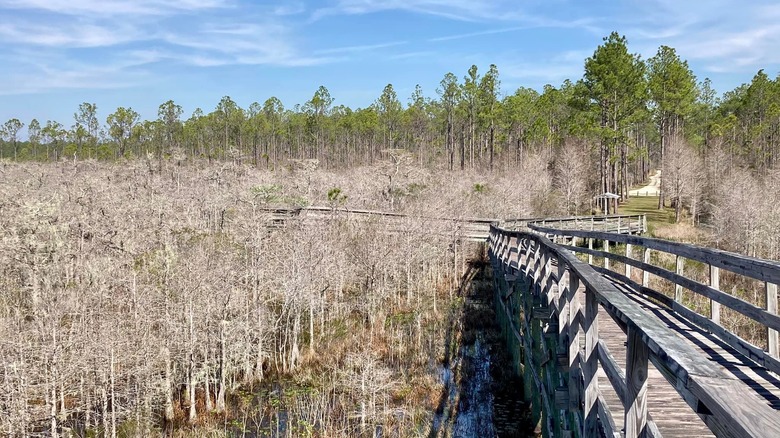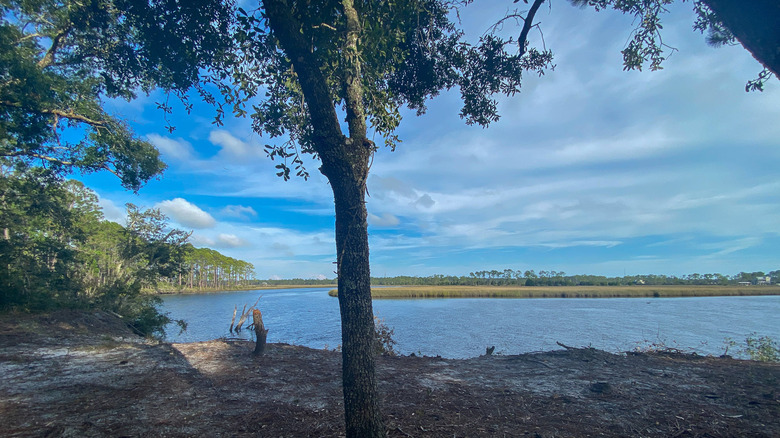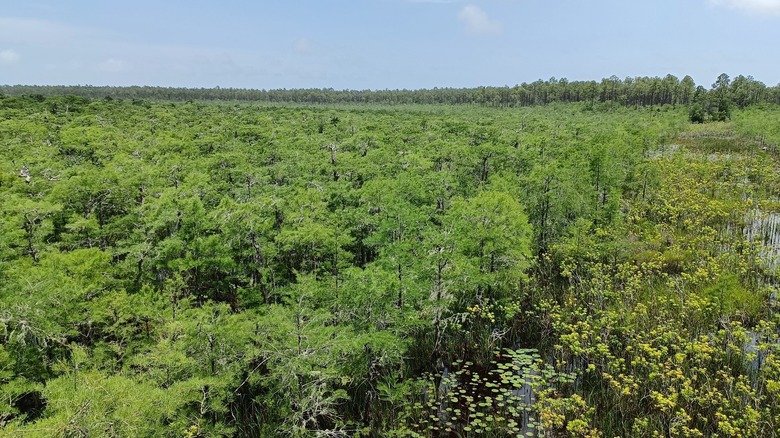The Diverse Landscape Of This Florida State Forest Has Stunning Trails For Hiking, Biking, And Exploring
Draped along Florida's Forgotten Coast, Tate's Hell State Forest sounds pretty sinister, but its origins are rooted in folklore. As the tale goes, in the late 1800s, a farmer named Cebe Tate ventured into the forest's sweeping coastal swampland to hunt down a panther that had been preying on his livestock. Entering the vast thicket with only a shotgun and his hunting dogs, the man soon became lost, wandering about aimlessly for seven whole days. After being bitten by a snake, he finally managed to make his way out of the marshy woodland, uttering the words, "My name is Cebe Tate, and I just came from Hell." It's said that his perilous misadventure led to his demise, and a legend was born.
For those bold enough to brave the supposed eerie past of Tate's Hell, an adventure-laden landscape awaits. The protected area encompasses more than 212,000 incredibly diverse acres, from wet prairies and flatwoods to bottomland forests and the aforementioned murky swamp. Home to some of the most scenic trails in Florida, from serene boardwalks to jungly paths, the forest beckons hikers, bikers, horseback riders, and every type of explorer in between.
Bounded by the Apalachicola and Ochlockonee Rivers, the forest lies on the outskirts of the city of Carrabelle. There, you'll find plenty of vacation rentals as well as a handful of boutique and budget-friendly abodes, such as the historic Old Carrabelle Hotel and the Franklin Inn. The Moorings of Carrabelle, a waterfront hotel perched along the Carrabelle River near the Gulf, also comes top-rated on Tripadvisor.
Roam the heavenly forest of Tate's Hell
Tate's Hell State Forest is part of the Big Bend Scenic Byway, a 220-mile Gulf Coast route through Florida's less crowded side, with miles upon miles of trails to roam. You can tackle the High Bluff Coastal Loop Trail, a nearly 9-mile path that winds through the wilderness. The trail is moderately challenging and can get quite muddy when it rains, so be sure to wear appropriate gear. If you'd prefer a shorter route, the trail's East Loop only spans 3.5 miles, while the West Loop is 5.5 miles. You can find the respective trailheads on opposite ends of the forest, where the main parking areas are located, just off of Highway 98.
Keep an eye out for wildlife, including a variety of native and migratory birds, such as bald eagles, brown-headed nuthatches, and red-cockaded woodpeckers. You may also be able to catch sight of deer, turkeys, and gopher tortoises, as well as more formidable species, such as Florida black bears, snakes, and alligators. Take a stroll along the Ralph G. Kendrick Boardwalk to see several stands of dwarf cypress, some of which are upwards of 150 years old. Though the region's cypress trees can grow to be more than 100 feet tall, the forest's miniature trees stand stunted, with none growing higher than 15 feet. The boardwalk also features an observation tower, so you can get an even better view from above.
Go wild in Florida's great outdoors
Don't want to hike Tate's Hell? You can explore the dense swampland in an off-roading vehicle, such as an ATV, UTV, or dirt bike, via the state forest's Off-Highway Vehicle Trail System. The special riding area features more than 150 miles of designated trails, which you can explore to your heart's content with the proper permit. Alternatively, you can saddle up and meander along the trails on horseback, unless there's signage posted that states otherwise. Just keep in mind that proof of a negative Coggins Test result is required for all equine.
Snake down more than 30 miles of rushing rivers, creeks, and streams in a kayak, canoe, or small boat. "We experienced Tate's Hell on land and by water," one prior visitor shared on Tripadvisor. "The entire area is a mishmash of swamp, forest, creeks and all the wildlife that goes with it. We canoed on the Pine Creek to get a different look at things. Had a beautiful and peaceful paddle," the review says, describing the forested surroundings as "more heavenly than hell."
At the time of writing, the cost to enter this remote corner of the Florida Panhandle is $2, and it's open from sunrise to sunset. If you want to stay longer, grab your best camping gear for a comfortable night outdoors and reserve a spot at one of the campgrounds, including the Womack Creek, Rock Landing, and Cash Creek sites. There are also primitive campsites sprinkled around if you really want to rough it in the wilderness. After all, home is where the tent is.


